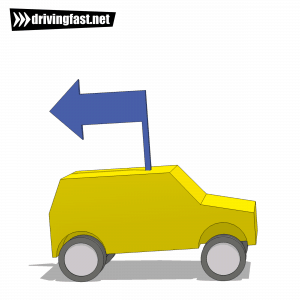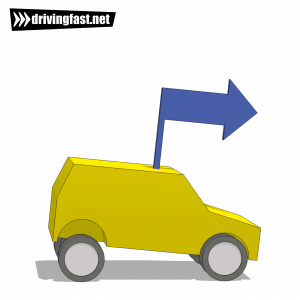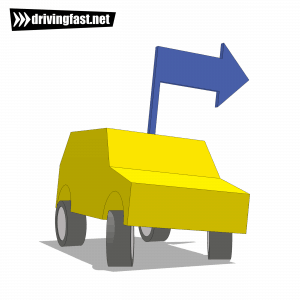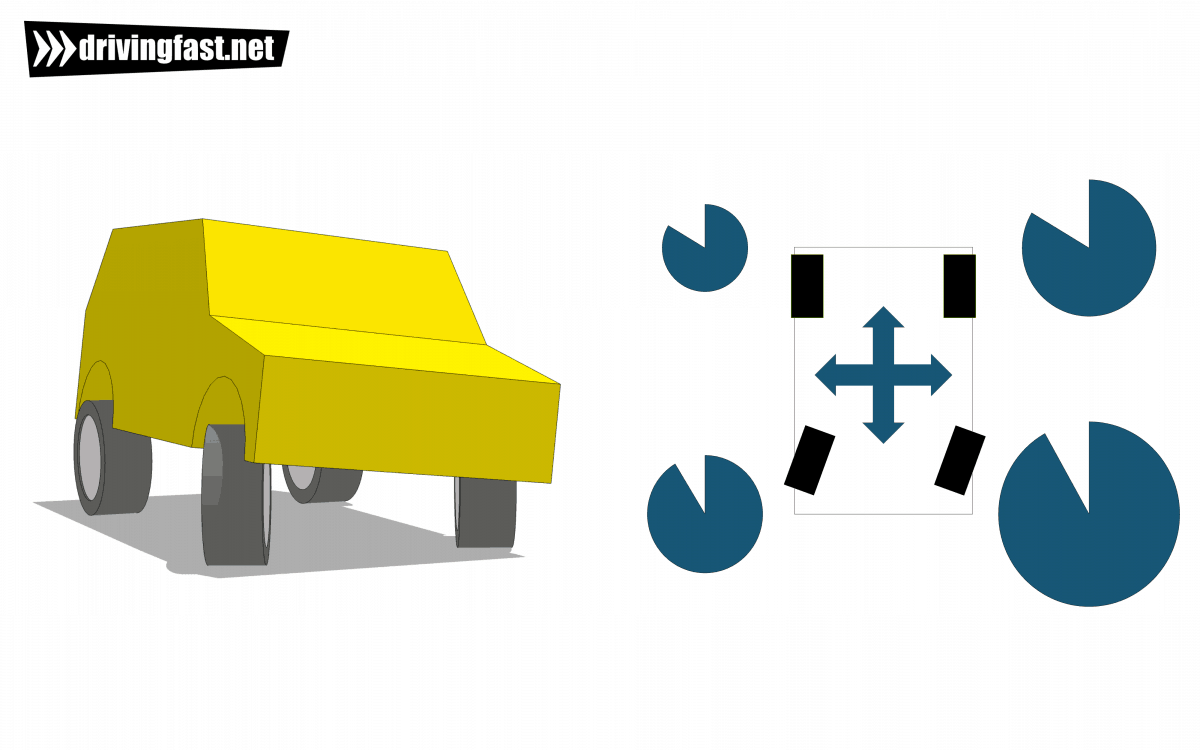Weight transfers
There are three ways that weight transfers can occur:
- Acceleration
- Deceleration
- Steering
Why do weight transfers occur?
Weight transfers occur as a result of the chassis twisting around the car’s roll centre, which determined by the natural suspension setup. When accelerating, braking or steering, the body of the car rotates in the opposite direction, which compresses the suspension on one side of the car, while releasing the weight on the other side.
Acceleration – rear weight transfer
When you accelerate, the weight of the car is thrown backwards (see Figure 2). This causes the rear suspension to compress slightly and increases the available grip at the rear tyres.
Advantages of rear weight transfer
1. Pulling away in a rear wheel drive car
If you’re trying to get a good start, rear weight transfer can play to your advantage in a rear wheel drive car, as the resulting increase in grip will provide you with more traction and reduce any wheel-spin. In a front wheel drive car, however, you’re more likely to get wheel-spin off the start, so an extra smooth throttle application is important.
2. Preventing oversteer in a front wheel drive car
Oversteer is caused by a lack of traction at the rear wheels, but if you accelerate in a front wheel drive car as oversteer is occurring, the resulting rear weight transfer can increase the available grip at the rear wheels and aid recovery. Note: Oversteer in a rear wheel drive car is rarely helped by acceleration, as this will increase the traction demands of the rear wheels, and leave less available grip to oppose the sideways motion.
Disadvantage of rear weight transfer
Can cause understeer
Understeer results from a lack of traction at the front wheels. If you’re accelerating into a corner, the levels of grip at the front wheels will be reduced due to the rear weight transfer, and be more prone to continuing in a straight line despite your steering inputs.
Deceleration – forward weight transfer
Cars can brake much harder than they can accelerate. Weight transfers under braking are thus more likely to affect the balance of the car (see Figure 3).
Advantage of forward weight transfer
Prevention of understeer
If you’re hurtling towards a corner, turn the wheel and find yourself ploughing straight on, you’ve probably approached too quickly. But all might not be lost – easing off the throttle will result in a forwards weight transfer which will increase the available grip at the front wheels. Hopefully this should correct your course. If you’re already off the gas, then a light dab on the brakes should help.
Disadvantage of forward weight transfer
Reduction of traction at the rear wheels
If you stamp rapidly on the brakes, you’ll find that the rear wheels (in a car without any clever technology) will tend to lock up first. This is the reason almost all cars have smaller brakes at the rear. Despite this fact, the rear wheels are still the most likely to lock when using the brakes aggressively. Braking in a corner should be avoided for the same reason, as this can result in oversteer.
Transitions in weight transfer
To get the best times on the track you need to be either accelerating or braking hard on the straights – any coasting means you’re not going as fast as you could. When transitioning between accelerator and brake you’ll get exaggerated weight transfers which can further upset the balance of the car.
Steering
It’s important to consider sideways weight transfers when cornering. If you turn into a corner progressively rather than ‘chucking it in’, this will transfer the weight to the outside wheels in a gradual manner. As the outside wheels provide most of the cornering effort, the resulting progressive increase in grip can help you take corners at a greater speed before traction is lost. However, if you throw the car into a corner, the sudden weight transfer can unsettle the vehicle and cause the wheels to break traction suddenly. The moral again ladies and gentlemen is smoothness.
An example
Let’s take our car and throw it into a corner hard on a neutral throttle. Diagram 4 below shows the levels of grip at each wheel. The pie charts indicate the amount of grip each wheel has (size of the pie) and show how much of the grip is used up.
While cornering, weight is transferred to the outside wheels, and thus they have more grip. The front wheels naturally tend to have more grip than the rear due to the weight of the engine. In the diagram above, much of this grip is currently being used to steer through the corner. The driver still has a small reserve of grip which could be used if the corner tightened. If the level of lateral grip at the front wheels is exceeded, understeer would result. The rear wheels require less grip to corner as this role is mostly performed at the front. If this were a rear wheel drive car, and the drive accelerated through the corner more of this rear grip would be used until eventually the car would oversteer.





This is a great tutorial that actually explains both the transfer and importantly the effect on each tyre.